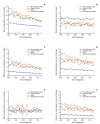A Comprehensive Assessment of the Racial and Ethnic Disparities in the Incidence of Gastric Cancer in the United States, 1992-2014
- PMID: 29921118
- PMCID: PMC6473285
- DOI: 10.4143/crt.2018.146
A Comprehensive Assessment of the Racial and Ethnic Disparities in the Incidence of Gastric Cancer in the United States, 1992-2014
Abstract
Purpose: This study aimed to evaluate the racial and ethnic disparities in the incidence of gastric cancer and their temporal trends in the United States.
Materials and methods: Using data from 13 cancer registries in the Surveillance, Epidemiology, and End results database, we assessed such disparities during 1992-2014 in the United States using a variety of disparity metrics.
Results: The age-standardized incidence rate of non-cardia gastric cancer was highest in Asian and Pacific Islanders, while the incidence of cardia gastric was highest in non-Hispanic whites in men and was similarly low in all groups in women. The incidence of non-cardia gastric cancer decreased in all groups over time, particularly in Asian and Pacific Islanders (on average by 3% per year). The incidence of cardia gastric remained relatively stable in virtually all racial/ethnic groups. The racial and ethnic disparities in gastric cancer incidence steadily decreased over time as measured on the absolute scale, which was mainly driven by the reduced disparities in non-cardia gastric cancer. The range difference in the incidence of gastric cancer decreased on average by 4.1% per year in men and by 2.6% per year in women from 1992 to 2014. The between group variance decreased by 5.6% per year in men and by 3.4% per year in women. The relative-scale disparity measures generally remained stable over time.
Conclusion: This study demonstrates decreased racial and ethnic disparities in the incidence of gastric cancer over time in the United States, particularly as measured on the absolute scale.
Keywords: Disparity; Incidence; Race/ethnicity; Stomach neoplasms.
Conflict of interest statement
Conflict of interest relevant to this article was not reported.
Figures



Similar articles
-
Sex difference in the incidence of cardia and non-cardia gastric cancer in the United States, 1992-2014.BMC Gastroenterol. 2020 Dec 11;20(1):418. doi: 10.1186/s12876-020-01551-1. BMC Gastroenterol. 2020. PMID: 33308167 Free PMC article.
-
Changing Disparity of Gastric Cancer Incidence by Histological Types in US Race-Specific Populations.Cancer Control. 2020 Jan-Dec;27(1):1073274820977152. doi: 10.1177/1073274820977152. Cancer Control. 2020. PMID: 33297759 Free PMC article.
-
Racial and Ethnic Disparities in the Incidence of Esophageal Cancer in the United States, 1992-2013.Am J Epidemiol. 2017 Dec 15;186(12):1341-1351. doi: 10.1093/aje/kwx221. Am J Epidemiol. 2017. PMID: 28641390 Free PMC article.
-
20-Year Comparative Survival and Mortality of Cancer of the Stomach by Age, Sex, Race, Stage, Grade, Cohort Entry Time-Period, Disease Duration & Selected ICD-O-3 Oncologic Phenotypes: A Systematic Review of 157,258 Cases for Diagnosis Years 1973-2014: (SEER*Stat 8.3.4).J Insur Med. 2019;48(1):5-23. doi: 10.17849/insm-48-1-1-19.1. Epub 2019 Oct 14. J Insur Med. 2019. PMID: 31609640
-
Racial disparities of gastric cancer in the USA: an overview of epidemiology, global screening guidelines, and targeted screening in a heterogeneous population.Gastric Cancer. 2024 May;27(3):426-438. doi: 10.1007/s10120-024-01475-9. Epub 2024 Mar 4. Gastric Cancer. 2024. PMID: 38436760 Review.
Cited by
-
Stomach Cancer Prediction Model (SCoPM): An approach to risk stratification in a diverse U.S. population.PLoS One. 2024 May 21;19(5):e0303153. doi: 10.1371/journal.pone.0303153. eCollection 2024. PLoS One. 2024. PMID: 38771811 Free PMC article.
-
Disaggregating Data on Pacific Islander Gastric Cancer Patients Reveals Survival Disparity.J Gastrointest Cancer. 2022 Mar;53(1):144-150. doi: 10.1007/s12029-020-00579-6. Epub 2021 Jan 4. J Gastrointest Cancer. 2022. PMID: 33392961
-
The burden of stomach cancer mortality by county, race, and ethnicity in the USA, 2000-2019: a systematic analysis of health disparities.Lancet Reg Health Am. 2023 Aug 4;24:100547. doi: 10.1016/j.lana.2023.100547. eCollection 2023 Aug. Lancet Reg Health Am. 2023. PMID: 37600165 Free PMC article.
-
Temporal Trends in Stomach and Colorectal Cancer Mortality by Racial Groups in Brazil (2000-2023): A Longitudinal Ecological Study.Int J Environ Res Public Health. 2025 Jan 31;22(2):208. doi: 10.3390/ijerph22020208. Int J Environ Res Public Health. 2025. PMID: 40003434 Free PMC article.
-
The uneven decline of gastric cancer in the USA: epidemiology of a health disparity.Lancet Reg Health Am. 2023 Aug 4;24:100551. doi: 10.1016/j.lana.2023.100551. eCollection 2023 Aug. Lancet Reg Health Am. 2023. PMID: 37600162 Free PMC article. No abstract available.
References
-
- Global Burden of Disease Cancer Collaboration. Fitzmaurice C, Allen C, Barber RM, Barregard L, Bhutta ZA, et al. Global, regional, and national cancer incidence, mortality, years of Life lost, years lived with disability, and disability-adjusted lifeyears for 32 cancer groups, 1990 to 2015: a systematic analysis for the global burden of disease study. JAMA Oncol. 2017;3:524–48. - PMC - PubMed
-
- Rugge M, Genta RM, Di Mario F, El-Omar EM, El-Serag HB, Fassan M, et al. Gastric cancer as preventable disease. Clin Gastroenterol Hepatol. 2017;15:1833–43. - PubMed
-
- Colquhoun A, Arnold M, Ferlay J, Goodman KJ, Forman D, Soerjomataram I. Global patterns of cardia and non-cardia gastric cancer incidence in 2012. Gut. 2015;64:1881–8. - PubMed
-
- Wu X, Chen VW, Ruiz B, Andrews P, Su LJ, Correa P. Incidence of esophageal and gastric carcinomas among American Asians/Pacific Islanders, whites, and blacks: subsite and histology differences. Cancer. 2006;106:683–92. - PubMed
Publication types
MeSH terms
Grants and funding
LinkOut - more resources
Full Text Sources
Other Literature Sources
Medical

